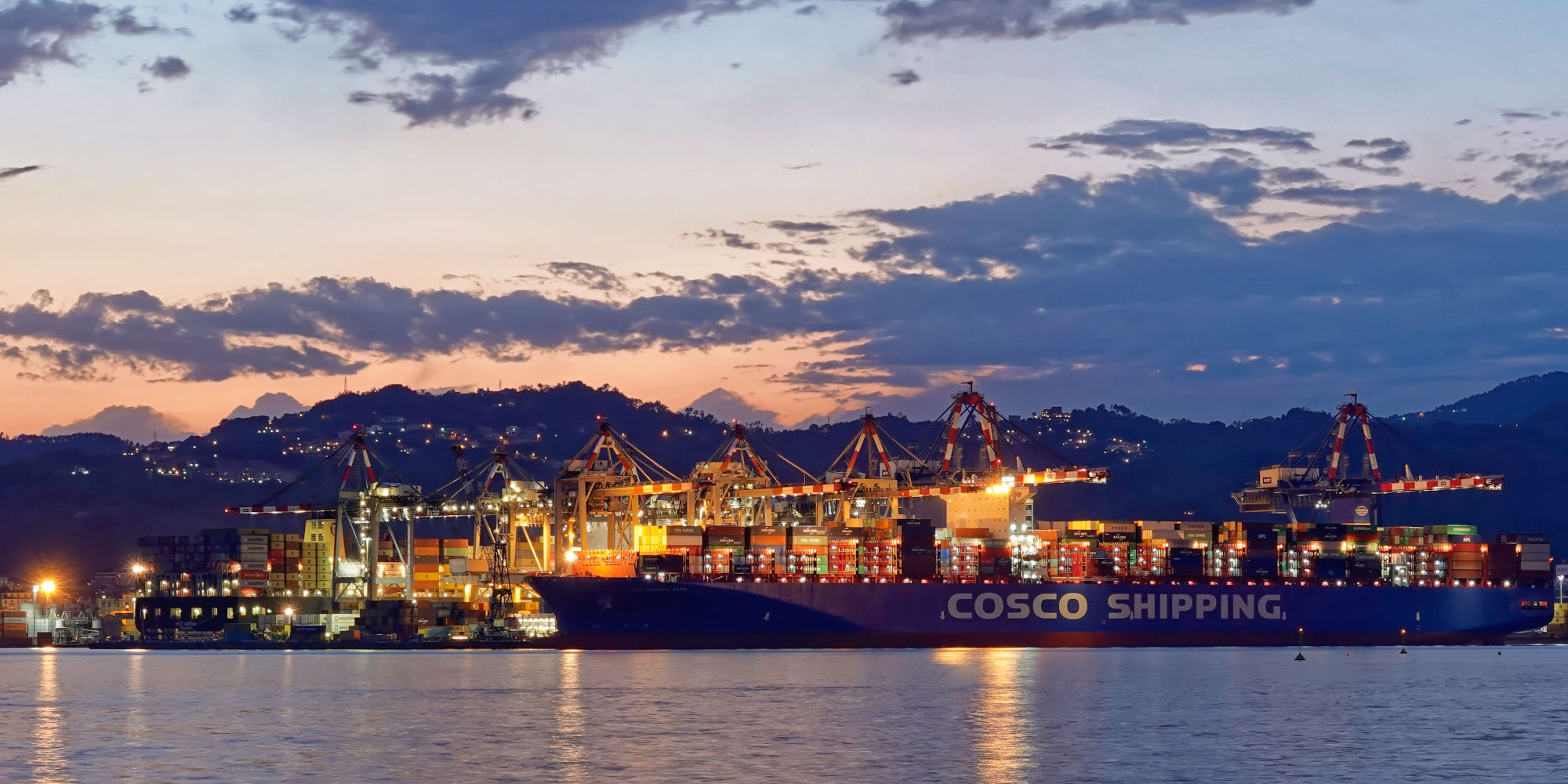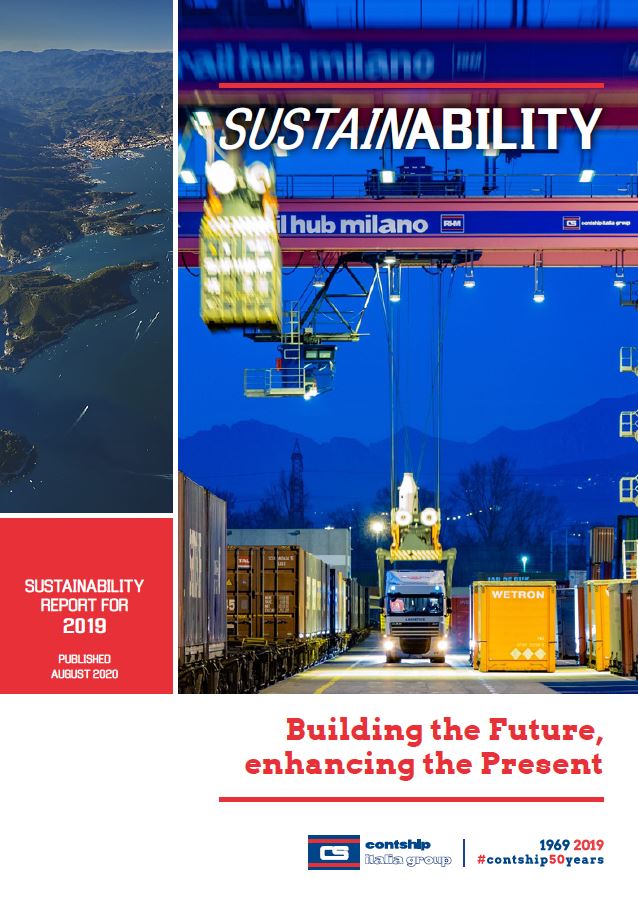Sustainability is an inherent element of Contship Italia’s mission. It is the DNA of the Group and it develops along three main axes.
The first one is the territories where the Group invests in and is physically active through concessions in port areas and the management of intermodal terminals. These infrastructures have both a direct impact in environmental terms, through the performance of their activities, the use of spaces and the handling processes (unloading, boarding, reloading on trains, trucks, ships), as well as an indirect impact, as a consequence of the activities carried out by users (for example the traffic of vehicles entering and leaving the terminals or the movement of ships).
The second axis on which Contship's sustainability projects move is represented by customers. In this case, the companies of the Group try to offer transport and handling solutions that customers can themselves promote as sustainable within their value chain.
The third axis, which is transversal to the first two, is the employees. In this case the goal is to create a healthy and sustainable work environment, giving strong importance to projects related to safety, positivity of social relationships, attention to gender balance and work-life balance, ultimately improving the quality of life at the work.
Sustainability in the terminals
The Contship Italia Group's infrastructures include both maritime terminals, including La Spezia Container Terminal and Terminal Container Ravenna, and intermodal terminals, such as Rail Hub Milano, in Melzo.
In this case, territories refer to a set of local people and institutions close to the terminals, with whom the Group engages through a business that must seek growth that have less environmental and social impact to each handled unit.
The search for growth also refers to a greater ability to offer the service, leveraging on the availability of yards and docks, equipped with machinery capable of developing ever greater productivity and efficiency.
Compared to the GRI standards, created by the Global Reporting Initiative, Contship analyzes activities in terms of impact on the territories envisaging a series of substantial investments to improve the environmental impact linked to three main sources typical of its business:
-
CO2 equivalent emissions
-
Particulate dust emissions
-
Noise emissions
Activities and investments pursued by the terminals are manifold and meet various objectives of reducing emissions and optimizing energy consumption.
From an energy point of view, the first initiative was the desire for deeper renewable energies penetration within the activities, by purchasing renewable electricity.
The second point is regarding the optimization of processes for energy recovery. For example, the electrically powered cranes that carry out container loading and unloading activities provide the possibility of recovering energy from the friction generated by the release of the container, braking it on its way down. It is the equipment’s technological development that seeks to maximize work capacity while minimizing energy consumption. This also leads to a lower balance in terms of CO2 emissions per unit handled.
The third terminal activity aimed at energy efficiency concerns the use of LEDs and solar panels. For years, the Group has started substantial investments that gradually replace luminescent lamps in light towers with LED. In the case of Melzo, solar panels were also installed along the perimeter of the new terminal inaugurated in 2015, which generate energy that can be used to power light towers and RMGs (Rail Mounted Gantry Cranes) used to load and unload the trains.
As for the impact of dust, the La Spezia terminal was among the first in Italy to experiment and use innovative fixing systems that allow a significant reduction in atmospheric emissions. In fact, handling activities by the vehicles inside the terminal generate fine dust due to the abrasion of tires or the raising from the base areas. Using fixing paints, it is possible to keep this dust pinned down to the ground. A closed-circuit washing system then takes care of surfaces cleaning and disposal of harmful elements, which would otherwise be dispersed into the environment as particulate matter.
To limit the acoustic impact, proper maintenance of vehicles and service areas is essential, which reduce problems and, consequently, the chances of vibrations and noise emissions.
In addition to maintenance activities, the Group aims to reduce noise emissions through the introduction of silent blocks. These systems are able to cushion the container’s fall when it is placed by the crane on the mobile vehicle (tractor or trailer).
The second significant investment was the replacement of all safety horns (reversing alarms) placed on the trailers with a white sound system. This system is characterized by a lower sound wave that is dispersed faster than traditional alarm tones and which is not only more effective (the wideband sound is more easily audible by operators wearing hearing protection devices and by people with hearing difficulties) but also much less impacting in terms of decibels, resulting in an appreciable noise abatement in terminals, especially those located near inhabited centers.
Some projects under development involve a collaboration with third parties. The first example is given by the collaboration with the ship commands so that the vessels during the stop on the quay can be positioned with the engine as far away from the inhabited areas as possible. The second example is the joint investment with the port authority for the use of cold ironing. This is the electrification of the docks so that moored ships can turn off their diesel generators and use the port's power system. This would reduce not only the noise of the generators but also the emissions of particulates and other non-altering gases.
Finally, as far as terminals are concerned, it is worth reminding that the mission of Contship Italia Group is to further develop intermodality. Consequently, in its infrastructures, Contship Italia Group tends to prioritize and promote the use of railway solutions for the transport of goods from the origin to the destination.
In this sense, La Spezia represents an excellence in Italy. In fact, over 30% of the goods handled on the quay entered or left using the train, when the national average for ports unfortunately stands at levels below 10%. In this ranking, only Trieste can boast similar performances for its port.
Sustainability as a value for customers
The second sustainability driver for Contship Italia Group is the value created for its direct customers, i.e. the desire to provide customers with transport solutions with a reduced environmental and energy impact, so that they can themselves pass on this benefit to the transport’s end users.
We are therefore referring to intermodality, that is, the shift from an all-road transport mode to one that sees the increasing importance of rail component. This is one of the main challenges of sustainable logistics: less than 7% of goods today in Italy are handled by rail or combined transport. It is therefore obvious that we are far from the European modal shift objectives, which envisage a combination of land transport by rail and road that includes at least 30% of transport by train and 70% by road.
Yet, the benefits of intermodal transport are evident: in fact, considering the costs relating to externalities of medium-haul transport, about 400km, the most recent studies conducted by Bocconi University argue that transport by truck, albeit of a new generation, impacts in terms of externalities (emission of climate-altering gases, congestion, accidents, noise, etc.) for an estimated cost of 0.5 euro per ton/km, while in the case of combined rail transport the cost drops to 0.049 euro, 10 times less.
Intermodality has multiple elements of sustainability.
On the environmental side, rail transport leads to a reduction in costs for CO2 emissions: the use of an electric locomotive on the main line has a better energy balance than road transport.
The second element of sustainability, which is often underestimated, is the social impact on the road haulage worker.
If we assume a long-distance transport, perhaps even cross-border, we imagine an average journey for a transporter lasting 2-3 days, during which the transporter must be able to reach a destination, find a load balance and return to another destination. It is evident that this is a very different job from that of a hauler employed on the short-haul distribution, typical of intermodal journeys. In this case, trucking is functional to the train and envisages missions compatible with a day job that allows the hauler, at the end of the mission, to return home comfortably, balancing his or her personal and family life in a more sustainable way.
Intermodality is therefore not in opposition to road transport. On the contrary, it allows road haulage to take advantage of its elements of flexibility and capillarity of the service, focusing them on short-haul routes.
In addition to these elements of sustainability endemic to intermodality, Contship is committed to invest to give a boost to the economic sustainability of rail transport, even on very short routes, within a radius of 200-230 km.
Hannibal, the Group's multimodal operator, has then worked on the integration of services, managing all physical assets (terminals and locomotives) and optimizing their use. Through its railway company Oceanogate Italia, triangular connections have been designed, which, instead of serving only two destinations with a single route, provide for connection with intermediate destinations before returning to the starting point.
This way, the rolling stock is engaged for longer times throughout the day, with a more balanced flow and subsequently the costs on the single process are reduced.
Other economic advantages include tax incentives programs offered by the European Community and by some member countries of the Union. In Italy, for example, Ferrobonus has been in place for several years. It is a subsidy in favor of intermodal transport or transport transhipped onto rail that can be requested by both user companies and combined transport operators (MTOs).
One last point worth-noting is that the Contship Italia Group’s committed to provide more transparency to its customers with which the equivalent CO2 emissions saved in relation to the mileage of transport carried out by rail are communicated monthly on the invoice. This process has been in place for more than 10 years for all Hannibal’s customers. Standard and recognized tools, such as Ecotransit, are used to calculate emissions.
Sustainability towards employees
The third axis on the sustainability concept which Contship Italia Group develops is the attention to resources.
Contship was among the first companies in its sector to introduce the so-called work-life balance, offering employees a series of useful services designed on the basis of their specific needs, collected through surveys. A process to understand the possible needs of employees, both personal and family. Based on the information collected, a corporate welfare model was therefore built to the advantage of both the company and the worker: the company has in fact provided tax- exemption possibilities for a series of bonuses that are given to its collaborators while employees can benefit from a range of useful services for themselves and their families. These services are constantly updated through the platforms that monitor workers’ satisfaction level and new needs.
In conclusion, Contship Italia Group has developed a 360 ° vision of sustainability concept starting from its core advantage: a company that by its nature works in a sea and land transport, which, unlike other industries, generally have limited impact on the environment.
Starting from this core advantage, a mission has been developed that determines the same identity and uniqueness of the Group: to promote independent terminal and intermodal transport solutions. It is therefore clear today that what is necessary and an obligation for many companies, for Contship it is just the continuation and further development of a mission that has already been in the company's DNA for over 50 years.






